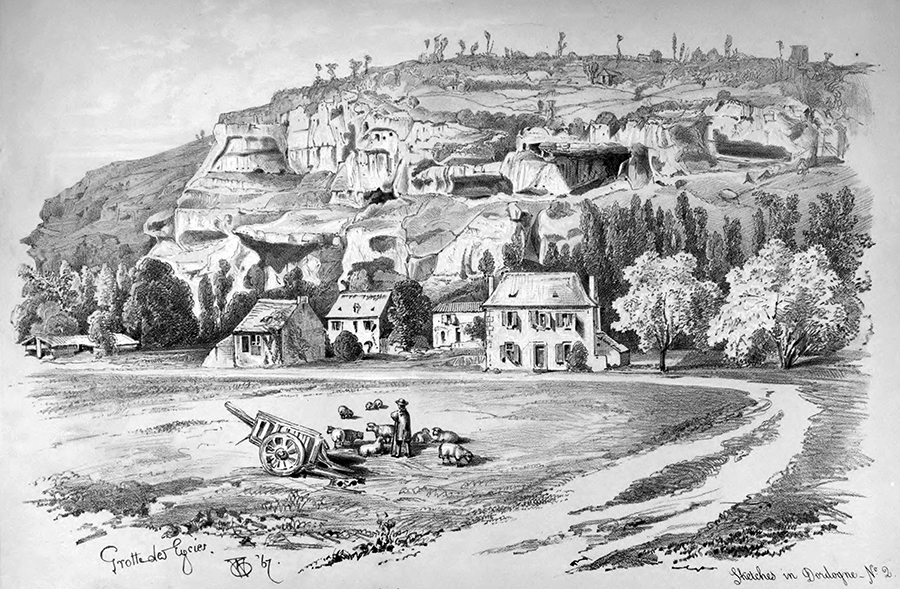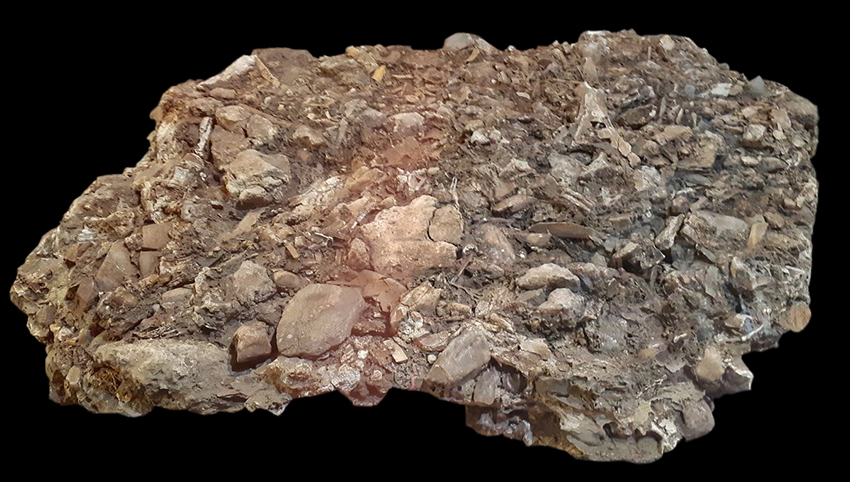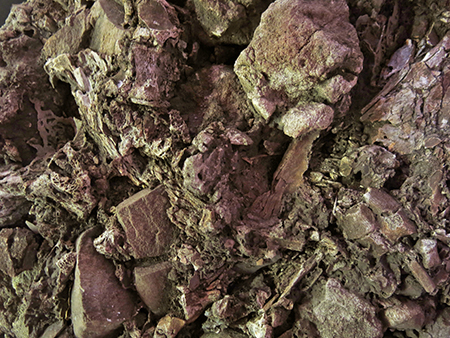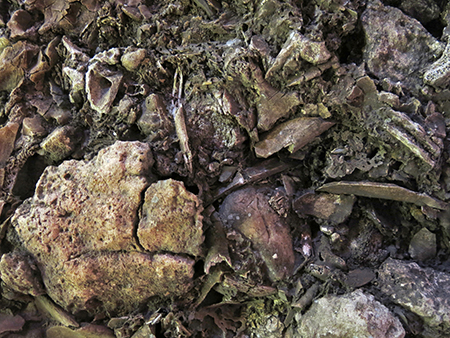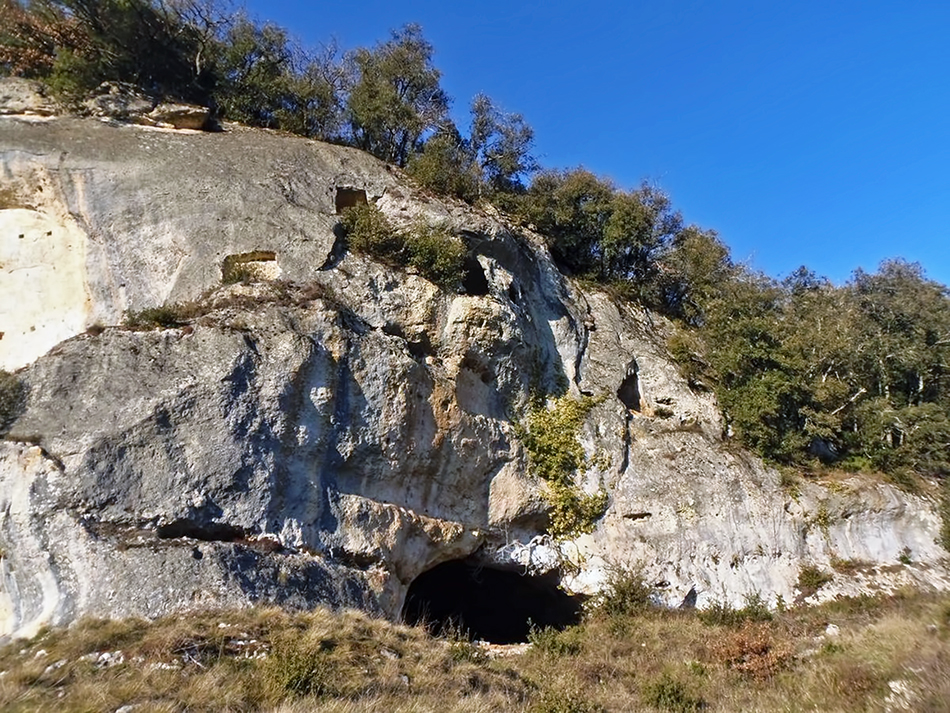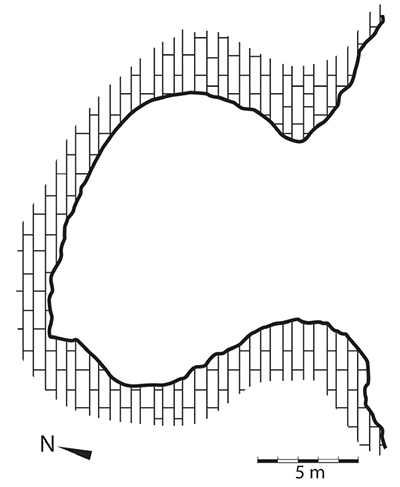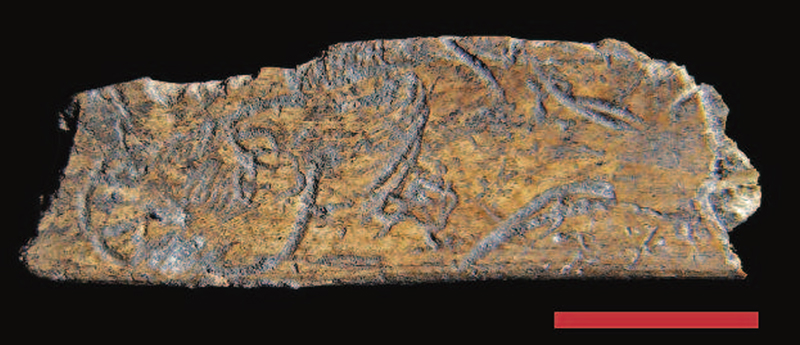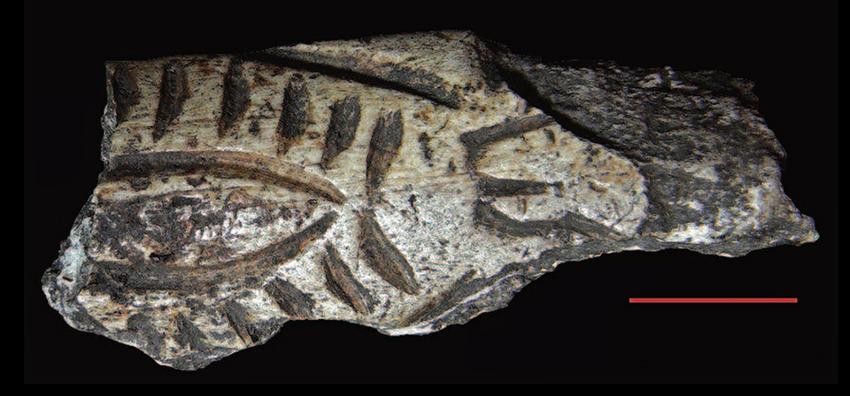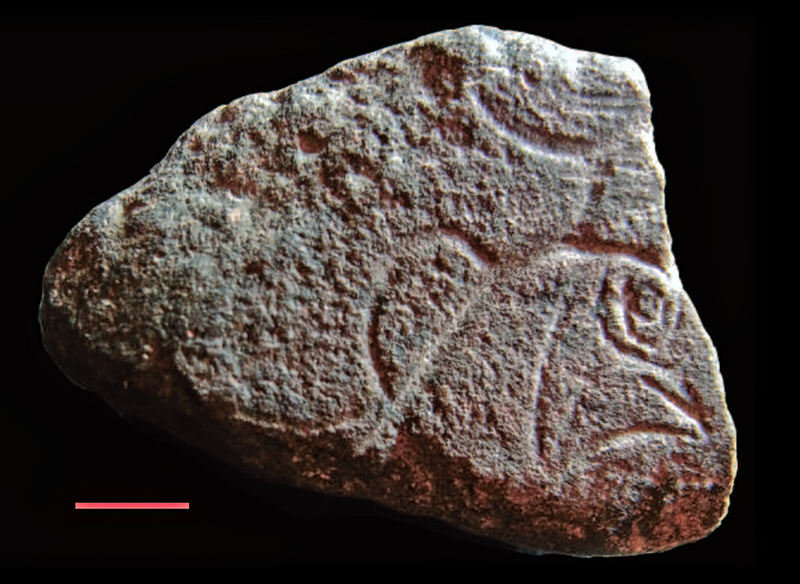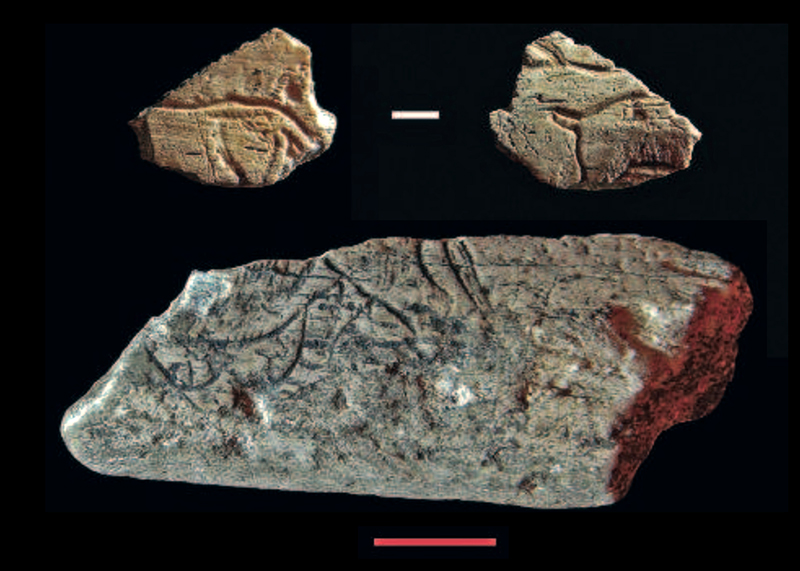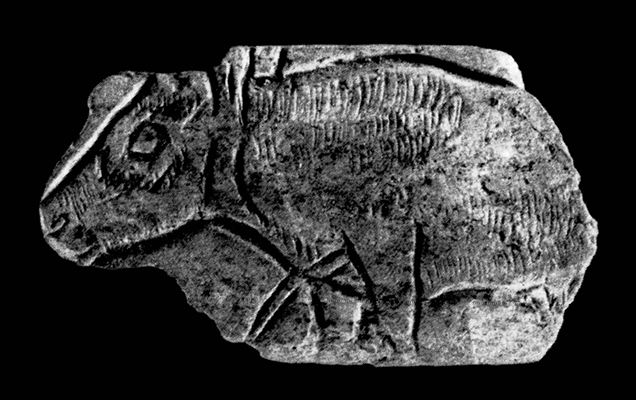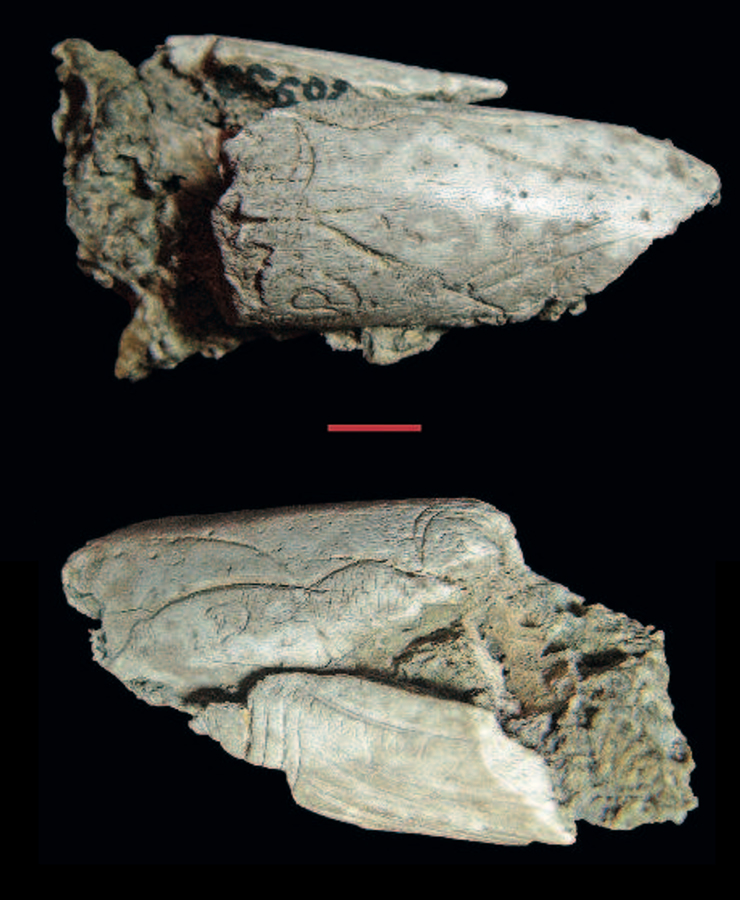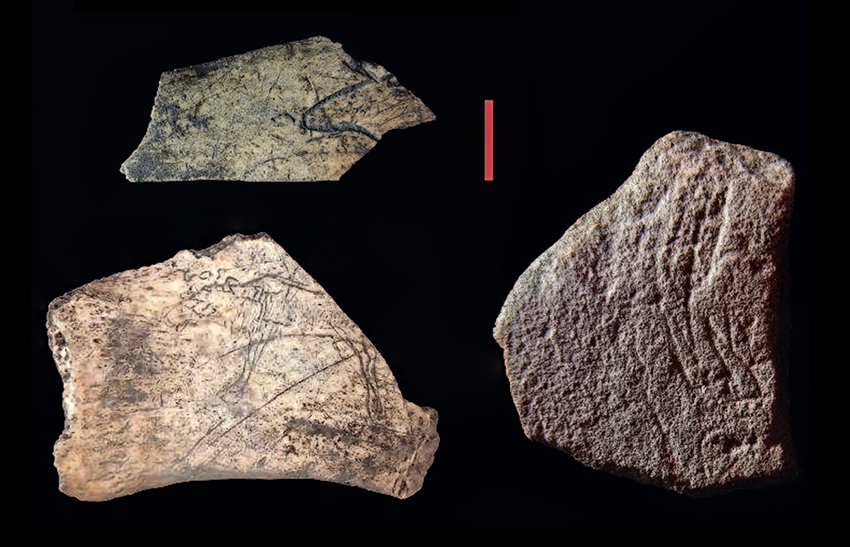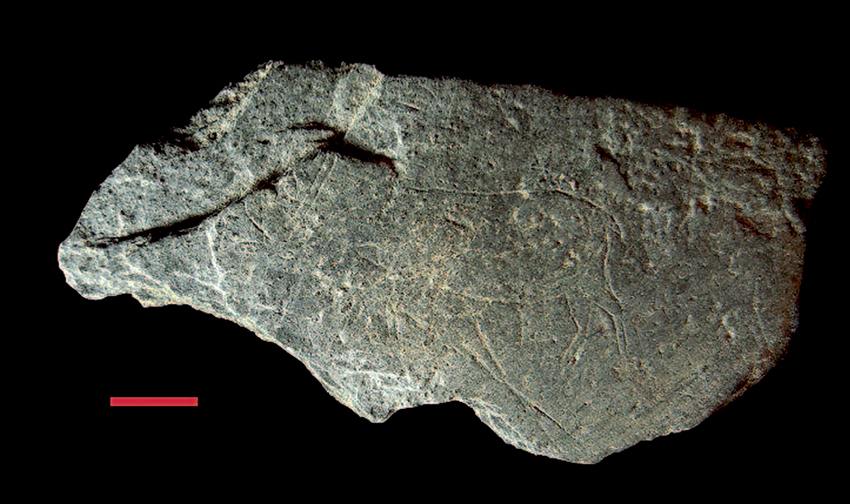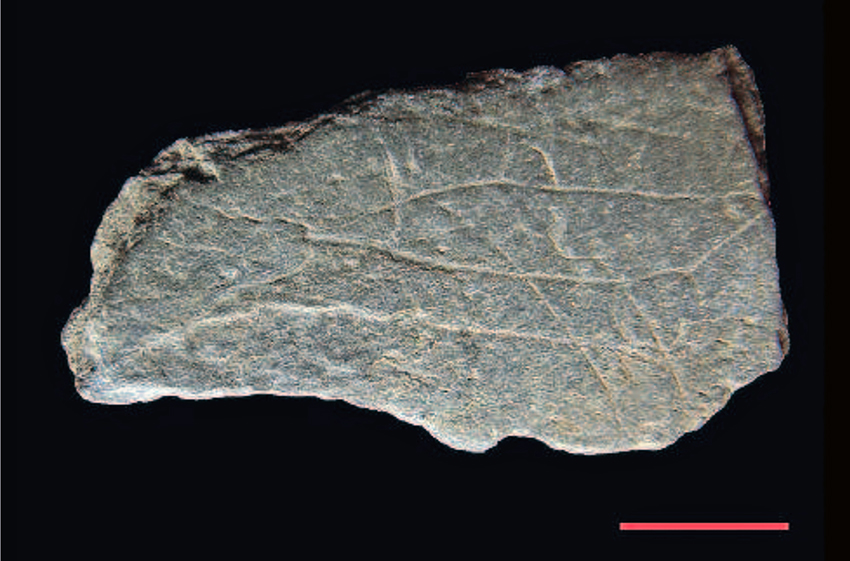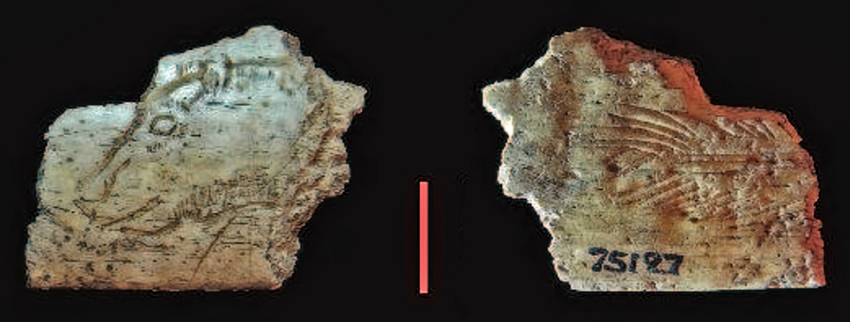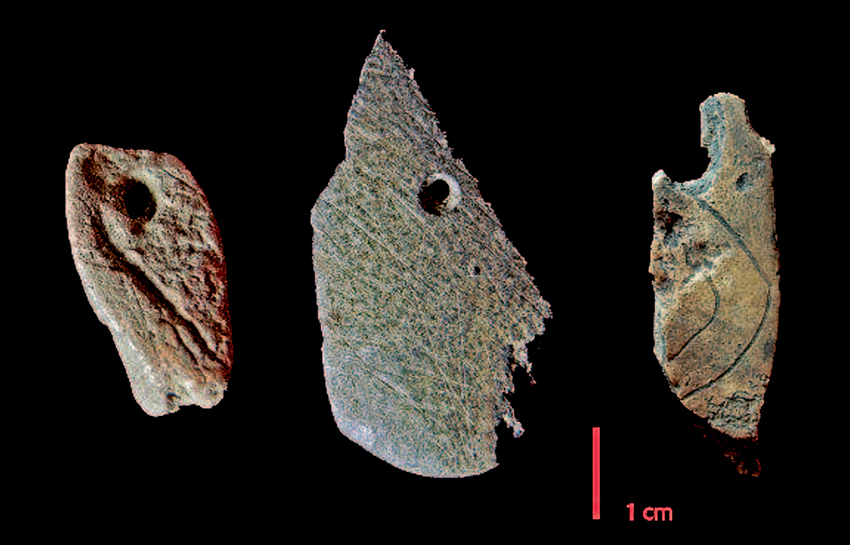Back to Don's Maps
Grotte des Eyzies / Grotte Richard
Click on the photos to see an enlarged version

Grotte des Eyzies / Grotte Richard
The area known as Les Eyzies, centred on the small town of Les Eyzies, is the single most important cave and abri area in the world, and from this point you can spend two weeks visiting very important archaeological areas in the immediate vicinity.
Photo: Don Hitchcock 2008
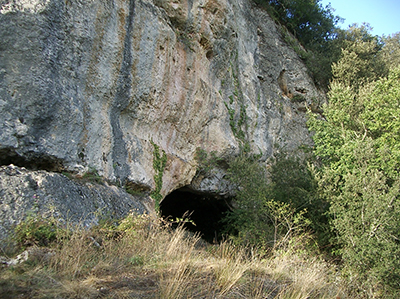
The Richard cave, or Les Eyzies cave, opens up in the middle of the holm oaks in the limestone escarpment which dominates the reception centre of the Pôle international de la préhistoire at Les Eyzies by about thirty metres.
Photo and text: Jean-Pierre, http://cartahu.blogspot.com/2012/12/la-grotte-richard-la-grotte-richard-ou.html
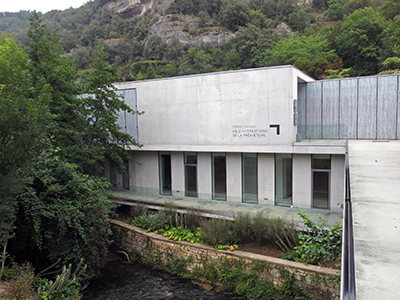
The Pôle international de la préhistoire at Les Eyzies is well worth visiting. They have an excellent archaeological display.
The Grotte des Eyzies is at the base of the cliff behind the exhibition hall.
Photo: Don Hitchcock 2014
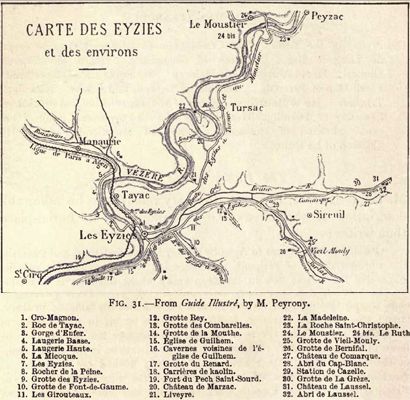
Map of the Les Eyzies area
Photo: Guide Illustré, by M. Peyrony published in Munro (1912)
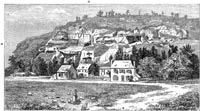
Les Eyzies Caves
Two lines, one horizontal, one vertical, drawn from a a meet in the centre of the principal cave
Photo: C. Lyell "The Antiquity of Man" (1873)
Les Eyzies Caves
Caption:
View of part of the village of Les Eyzies, near the junction of the Beune and the Vézère, showing the position of the Cave worked out by Messrs. H. Christy and E. Lartet. Taken by W. Tipping Esq., F.S.A., October 1864.
Sketch: W. Tipping Esq., F.S.A.
Source: Lartet and Christy (1875)
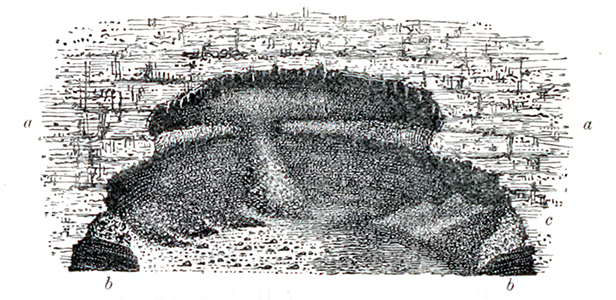
Diagram of the cave deposits at Les Eyzies.
a Limestone
b Hearth-stuff, with bones, flint flakes, and implements of stone and bone.
c Breccia of limestone cemented with stalagmite
Photo: After fig 63, Lartet and Christy (1875)
In Périgueux, the Museum of Art and Archeology of Périgord has in its collections a curious block of blackish agglomerate from la Grotte Richard, as shown in the image above.
'This fossilised breccia contains carved flints, crushed bones, bone tools, and stone tools' explains Véronique Merlin-Anglade, Curator and Director of the Périgord Art and Archeology Museum, at Perigueux.
Photo and text: © Radio France - Christophe Tastet
Proximal source: www.francebleu.fr
Source: Original, Musée d’art et d’archéologie du Périgord, Périgueux
An agglomeration of various materials: bone, flint, burnt pebbles and charcoal, fragments of limestone detached from the rock face, which accumulated on prehistoric settlement sites, and here were cemented by calcium carbonate carried by seepage water.
These remains are at the base layer of the excavation undertaken by the palaeontologist Edouard Lartet and his friend Henry Christy in the Vézère valley in 1863, during which they unearthed the first movable art objects in the Dordogne, and found indisputable proof of the contemporaneity of man and extinct animal species (such as a mammoth engraved on mammoth ivory) at La Madeleine.
Photo: Don Hitchcock 2015
Source and text: Original, display at Musée d’art et d’archéologie du Périgord, Périgueux
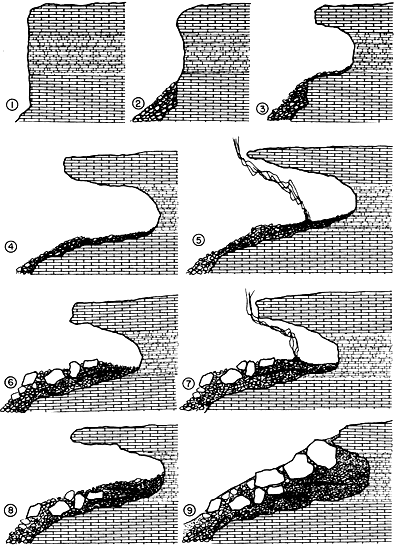
The evolution of a rock shelter and its deposits.
When a zone of weaker rock underlies a stronger stratum, frost weathering (freeze/thaw cycle) cuts away the softer rock, creating a rock shelter. (The initial formation and subsequent undercutting of a cliff can also be caused by a river.) When this provides enough shelter, it becomes occupied. The roof periodically falls, covering the occupation material of bones, ash, and artefacts with rock and dust, the shelter is reoccupied, and the cycle continues until the rock shelter becomes completely filled in.
It would be hard to think of a better method for preserving fossils from the stone age than this, though it is tough on any inhabitants at the time of the rock falls.
Photo: H. Laville et al, 'Rock Shelters of the Perigord'
Entrance to Grotte Richard.
Photo: media.sudouest.fr
Plan of Grotte Richard.
Photo: After Andrieux et Bouvier 1967, DAO (CAD) E. Deneuve
Source: books.openedition.org/pup/55407
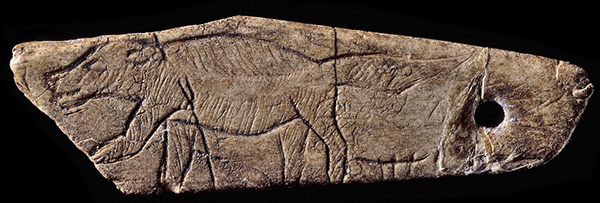
Engraved bone pendant decorated on one side with a drawing of a wolverine facing away from the perforation. The engraved drawing fits tightly into the shape of the thin bone blank that did not allow space for the right front and back paws.The animal is confidently engraved with a relatively deep-cut outline showing its characteristic body shape, ears nose and eyes. Fine internal shading indicates the distinctive markings of the fur.
An oblique line that divides into two prongs at the tip extends from below the lower edge of the piece, across the body into the shoulder of the animal. Another extends from the upper edge into animal's neck at the same angle as the longer, lower line. Behind the left back leg there is a horizontal incision crossed over by three short vertical lines, another of which occurs just beyond the end of the horizontal incision.
There are slight ancient damage scars at the tip of the piece but the oblique lower edge is worked smooth indicating that it is not a break. The reverse is not decorated but the internal spongiosa structure of the bone is worked down, smoothed and slightly polished. The area around the perforation shows that the hole was started by scraping the outer bone surface prior to drilling it through from the decorated side. The piece has a repaired break of historic rather than ancient origin across the lower part of the perforation.
Length 60 mm, thickness 1.5 mm, width 18 mm.
Late Magdalenian, 16 000 BP - 14 000 BP
Excavated by Edouard Lartet, who worked with Henry Christy who paid for the lease of the site and remunerated the workmen.
Excavated by: Henry Christy
Findspot: Grotte des Eyzies
Photo and text: British Museum © Trustees of the British Museum, CC BY-NC-SA 4.0
Double bevelled reindeer antler point with deeply engraved drawings of two ibex distinguished by their characteristic horns with raised rings along the length. They are depicted one behind the other, on each side facing the damaged tip of the point. The ancient damage to the tip has an impact fracture scar on one side but the presence of the tail and part of the rump of another ibex on the margin of the break indicates that the point was engraved before use rather than the broken piece being recycled as a blank for the drawings.
Both male and female ibex have horns that are carried throughout their lives.The male horns are larger, more or less divergent according to species and recurve at the back. Female horns are shorter and narrower. It is difficult to distinguish such differences from the engravings on the point with any certainty, especially as the horns are unnaterally flattened and drawn to fit into the space and around the curvature of the point rather than realistically. However, the absence of the beard, clearly depicted on the male ibex portrait drawn on bone from Courbet Cave (Palart.505) may suggest this group are females rather than males.
Ibex are short and stocky as depicted here but only the tops of the legs are depicted in the engraving leaving space for the large, powerful bodies. Nevertheless, the drawings indicate that the legs are extended in motion and the raised, typically stubby tails are also indicative of the animals walking. Fine oblique and vertically incised lines indicate the pelts but insufficiently detailed to be indicative of season.
On the upper edge, the horns and backs of the animals form a well-composed pattern suggestive of the backs of two more animals viewed from above with a sign with three points between the the horns of the two following animals. The lower surface is formed by the rough spongiosa of the exposed inner part of the antler.
The bevel surfaces are obliquely scored as on most points. This scoring is functional rather than decorative, improving the friction grip that holds it it tight when inserted into the spear shaft.
Magdalenian, 17 000 BP - 13 000 BP
Length 151 mm, thickness 12 mm, width 15 mm.
Catalog: Reindeer antler, Palart.100
Findspot: Grotte des Eyzies, also known as Grotte Richard
Photo and text: British Museum © Trustees of the British Museum, CC BY-NC-SA 4.0
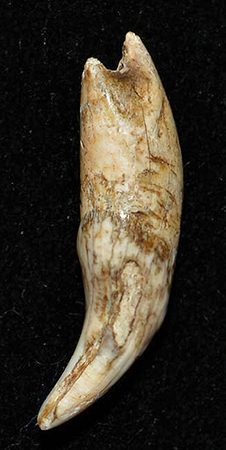
Personal ornament made from the canine tooth of a small carnivore perforated through the base of the root for use as a bead or pendant. The hole is made through the sides of the tooth. The root has broken across the hole and the proximal tip is missing.
Magdalenian, 17 000 BP - 13 000 BP
Length 19 mm, thickness 4 mm, width 6 mm.
Excavated by Edouard Lartet.
Catalog: Canine tooth, Palorn.104
Findspot: Grotte des Eyzies, also known as Grotte Richard
Photo and text: British Museum © Trustees of the British Museum, CC BY-NC-SA 4.0
Frieze of six ibex engraved on a fragment of the rib of a large herbivore.
Photo: Don Hitchcock 2014
Source: Original on display at Le Musée National de Préhistoire, Les Eyzies-de-Tayac
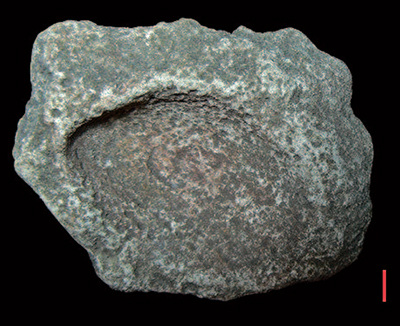
Godet, receptacle for ochre, (paintpot), made of sandstone.
Catalog: MAN 60071
Photo: © É. Deneuve
Findspot: Grotte des Eyzies, also known as Grotte Richard
Source and text: Deneuve et Man-Estier (2014)
Bone fragment engraved with a horse’s head.
Catalog: MAN 86171
Photo: © É. Deneuve
Findspot: Grotte des Eyzies, also known as Grotte Richard
Source and text:: Deneuve et Man-Estier (2014)
Bone blade engraved with a geometric 'mandorla' pattern and a herbivore head (nose).
( A mandorla is an almond-shaped aureola, i.e. a frame that surrounds the totality of an iconographic figure - Don )
Catalog: MAN 60103
Photo: © É. Deneuve
Findspot: Grotte des Eyzies, also known as Grotte Richard
Source and text: Deneuve et Man-Estier (2014)
Additional text: Wikipedia
Sandstone block engraved with a bird's head.
Catalog: MAN 76937
Photo: © É. Deneuve
Findspot: Grotte des Eyzies, also known as Grotte Richard
Source and text: Deneuve et Man-Estier (2014)
Three herbivores, including two equids.
Catalog: MAN 60097, MAN 60095
Photo: © É. Deneuve
Findspot: Grotte des Eyzies, also known as Grotte Richard
Source and text: Deneuve et Man-Estier (2014)
Bovid engraved on bone, from la Grotte Richard.
Collection: Lartet-Christy, Musée des Antiquités Nationales
Source: Roussot (1990)
Brecciated bone fragment. Geometric patterns, a bovine head, and the dorsal line of another animal have been engraved on it.
Catalog: MAN 76938 or MAN 76939
Photo: © É. Deneuve
Findspot: Grotte des Eyzies, also known as Grotte Richard
Source and text: Deneuve et Man-Estier (2014)
From top to bottom, and from left to right: bone blade engraved with the head of a herbivore, fragment of scapula engraved with a figure of a young reindeer, sandstone block engraved with the partial head of a goat (young ibex?)
Catalog: MAN 60089, MAN 60090, MAN 60074
Photo: © É. Deneuve
Findspot: Grotte des Eyzies, also known as Grotte Richard
Source and text: Deneuve et Man-Estier (2014)
Schist plate engraved with a reindeer figure.
Catalog: MAN 60087
Photo: © É. Deneuve
Findspot: Grotte des Eyzies, also known as Grotte Richard
Source and text: Deneuve et Man-Estier (2014)
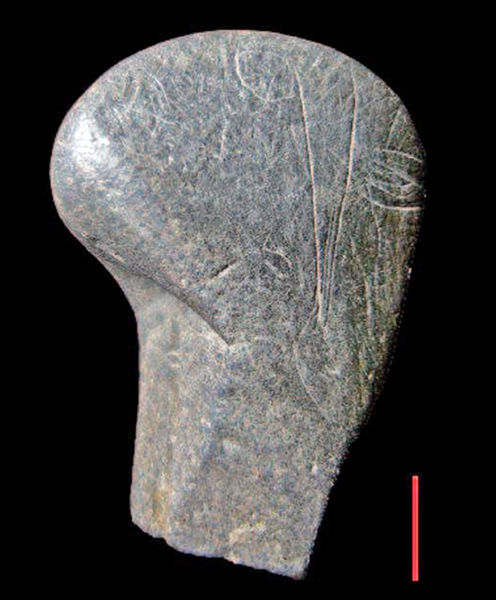
Schematic human head carved on a schist pebble.
Catalog: MAN 60092
Photo: © É. Deneuve
Findspot: Grotte des Eyzies, also known as Grotte Richard
Source and text: Deneuve et Man-Estier (2014)
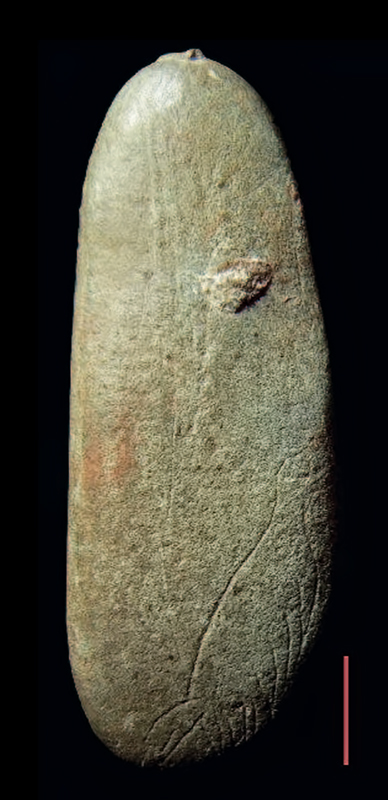
Schist pebble engraved with the figure of a bird.
Catalog: MAN 35439
Photo: © É. Deneuve
Findspot: Grotte des Eyzies, also known as Grotte Richard
Source and text: Deneuve et Man-Estier (2014)
Schist plate engraved with a phallus.
Catalog: MAN 60087
Photo: © É. Deneuve
Findspot: Grotte des Eyzies, also known as Grotte Richard
Source and text: Deneuve et Man-Estier (2014)
Bone fragment engraved with a bear's head on one side and a 'spike' or 'feather' pattern on the other.
Catalog: MAN 75127
Photo: © É. Deneuve
Findspot: Grotte des Eyzies, also known as Grotte Richard
Source and text: Deneuve et Man-Estier (2014)
Three pendants: ochre, schist, and bone.
Catalog: MAN 60102, MAN 60078, MAN 60093
Photo: © É. Deneuve
Findspot: Grotte des Eyzies, also known as Grotte Richard
Source and text: Deneuve et Man-Estier (2014)
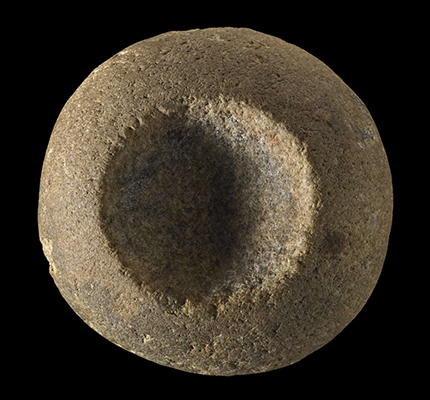
Lamp made on a quartzite cobble hollowed out by pecking to form a saucer shaped depression to hold tallow and a wick on the upper surface. Upper surface blackened. Some reddening of sides.
Magdalenian, 17 000 BP - 13 000 BP
Length 127 mm, thickness 63 mm, width 53 mm.
Excavated by Henry Christy.
Catalog: Christy French Caves, 335
Findspot: Grotte des Eyzies, also known as Grotte Richard
Photo and text: British Museum © Trustees of the British Museum, CC BY-NC-SA 4.0
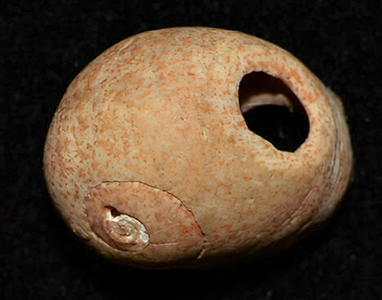
Personal ornament made from the shell of a sea snail (winkle) perforated for threading through zone 1 on the back opposite the mouth. The shell is complete.
Magdalenian, 17 000 BP - 13 000 BP
Length 14 mm, thickness 9 mm, width 9 mm.
Excavated by Edouard Lartet.
Catalog: Palorn.100
Findspot: Grotte des Eyzies, also known as Grotte Richard
Photo and text: British Museum © Trustees of the British Museum, CC BY-NC-SA 4.0
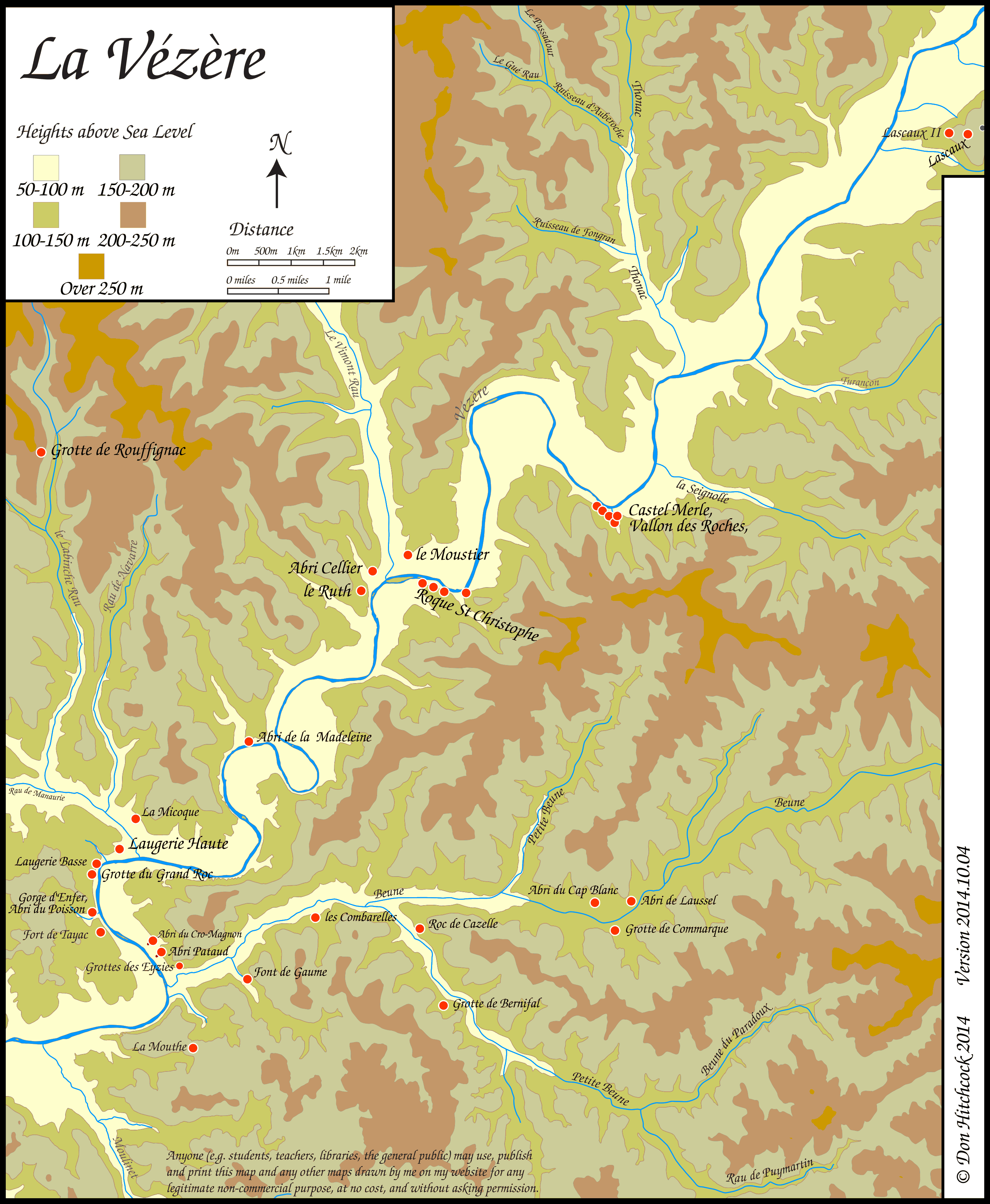
Map of sites in the Vézère Valley of France, including Les Eyzies.
If you click on the map you will see a larger map with the ability to click on the marked sites and get further information.
Photo: Don Hitchcock
The following is adapted from Daniel (1972)
Le Grotte des Eyzies, also known as the Grotte Richard, is located on the left bank of the Vézère. It opens to the SSE in the line of rocky cliffs which border the right bank of the Beune, a few hundred metres to the East of the Château-Musee des Eyzies and 35 metres above the line of the river. It has an ovoid shape and, according to measurements made in 1966 by J.-M. Bouvier, its actual dimensions are as follows:
It is a large open porch 9 metres wide and 3.2 metres high. the cave is 15 metres wide, 11 metres deep and the highest point of the vault is 5.40 metres above the present ground, approximately horizontal.
When in 1863 Lartet and Christy entered this cave, they found on the floor a very hard black breccia, which was made of bones and cut flints, from which they were able to extract large slabs which are now scattered in various National Museums.
But this cave, like many others in the Eyzies region, had been occupied in the Middle Ages and partly emptied of its filling. This is how the most recent archaeological levels were emptied on the neighbouring terraces. Lartet and Christy, whose work was located in the cave itself, did not touch this disturbed soil.
It was not until 1903 that D. Peyrony had the idea of exploring this mass of earth hidden under the grass, which was archaeologically very rich. The lithic and bone material from the Eyzies cave is scientifically very poorly known, because apart from what may be contained in the large slabs of breccia collected on the floor of the cave, which it would be a pity to sacrifice to excavate them in the laboratory, we only have objects collected long ago, or in the rubble.
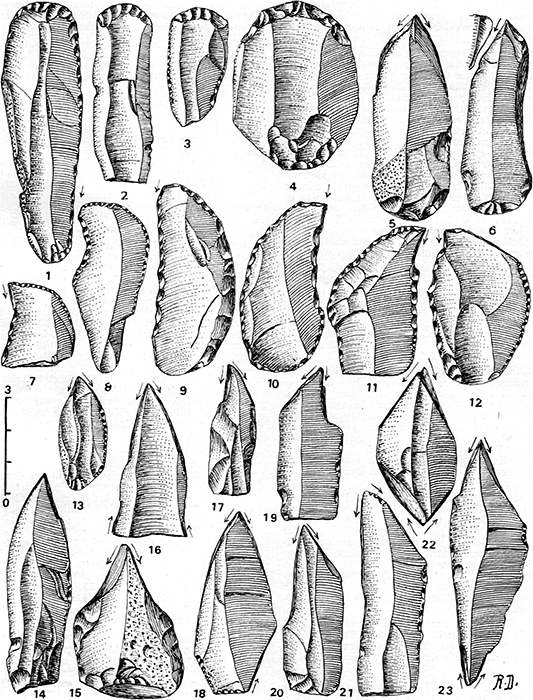
Figure 1: Grotte des Eyzies, Upper Magdalenian lithic tools
1, 2: Simple scrapers on a rough blade.
3: Retouched scraper (fig. 1, no. 3).
4: Scraper on a flake.
5,6: Scraper - burins.
Parrot beaked burins are represented in notable quantity:
7, 8, 9: Parrot beaked burins turned to the left.
10, 11: Parrot beaked burins turned to the right.
12: Parrot beaked burin turned to the left.
13, 14, 15: Straight dihedral burins, which are the dominant tool.
16: Right-handed dihedral opposed to two corner burins on a break ( fracture that cuts the point across its entire width and removes a part of both lateral edges (apex fractures) or of both surfaces (edge fractures) - Don )
17: Lopsided dihedral burin
18: Right-handed dihedral associated with a right-handed truncated burin.
19: Dihedral angled burin
20, 21: Lopsided dihedral burins
22, 23: Double burins.
Drawings and text: Daniel (1972)
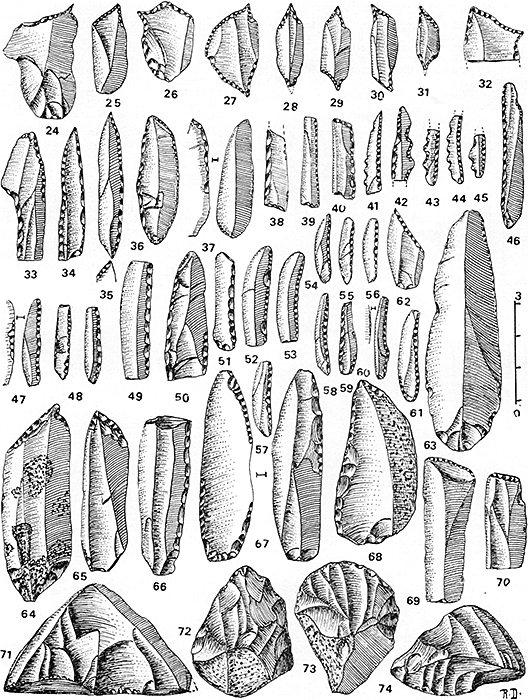
Figure 2: Grotte des Eyzies, Upper Magdalenian lithic tools
33: Magdalenian pointe à cran or shouldered point, used as a spear or dart point.
34: Point of the Gravettian type with a retouched edge.
35: Point of the Gravettian type with a reverse proximal retouch.
36: Blade with an abrupt retouch on one side and a thin, short, continuous retouch on the other.
37: Blade with a partial reverse semi-abrupt retouch.
38, 39, 40: Truncated small blades with a back.
41, 42, 43, 44, 45: Small denticulated blades with a back.
46: Small blade with a back.
47: Blade with a partial reverse retouch on the back
48: Dufour blade with an alternate retouch ( Dufour blades or bladelets were produced as a byproduct of the knapping of carinated and nosed scrapers, and were used as points on spears/darts and as hafted small knives for meat and soft vegetable matter. - Don ).
49-61 small blades with a back, mostly in fragments.
62: Blade with oblique truncation.
63: Blade showing traces of use.
64: medium-sized double perçoir (awl) from truncation.
65: Blade showing retouching.
66: Pointed blade showing retouching.
67: Blade with abraded back.
68: Knife with natural back and retouched edge.
69: Blade with convex truncation.
70: Blade showing straight truncation.
71: Double plane scraper.
72, 73, 74: Carinated scrapers.
Drawings and text: Daniel (1972)
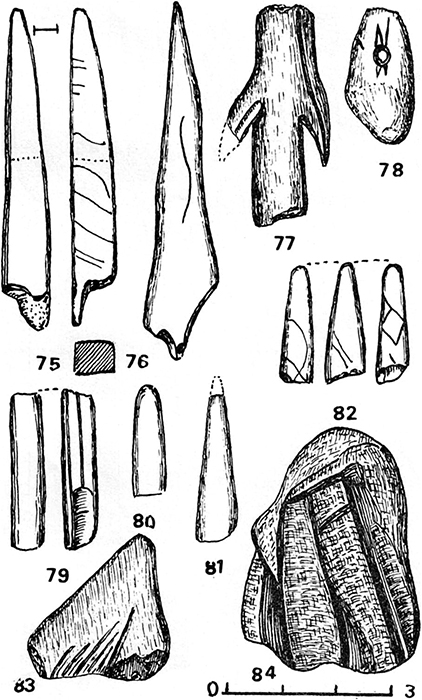
Figure 3: Grotte des Eyzies, Upper Magdalenian, bone tools, piece of red ochre (#83), Sandstone polisher (#84)
75: Fragment of a sagaie of quadrangular cross section, one of its sides decorated with lines.
76: Bone awl.
77: Fragment of a harpoon with bilateral incised barbs.
78: Perforated canine tooth of a deer.
79: Fragment of a sagaie with two grooves.
80, 81: Two distal ends of round-section sagaies.
82: Fragment of a sagaie of quadrangular cross section bearings engraved lines and a diamond-shaped decoration.
83: Piece of heavily scraped red ochre
84: Soft sandstone polisher with deep grooves.
Drawings and text: Daniel (1972)
Description of the Grotte des Eyzies from Lartet and Christy (1875):
It is a fine vaulted cave, in plan approximating to a segment of a circle about 50 feet in diameter, with an arc of about 90 degrees cut off to form the opening. Its floor is a continuation of a ledge of rock nearly 120 feet above the river, the face of the cliff being at this spot divided into steps or terraces in much the same manner as at Le Moustier. There is a stalactitic coating over much of the roof; and the greater part of the floor of rock was, before Messrs. Lartet and Christy's explorations, covered by a layer of hard breccia from 4 to 10 inches thick, cemented by the infiltration of water charged with calcareous matter as shown in fig. 63 above.
Above this there had formerly existed a looser deposit, of the nature of a kjokken- modding ( now more widely known as shell middens - Don ), from 2 to 3 feet in thickness, which had been removed some years ago, but of which some portions remain cemented by stalactite to the walls of the cave. The stalagmitic breccia from the floor contains, as usual, a number of worked flints of much the same character as those from La Madelaine, and also many pebbles of quartz, gneiss, granite, and other rocks, some of which have been used as hammers, and others have been exposed to the action of fire.
Some of the rounded stones, with mortar-like depressions in them, have been found here, and also several pieces of haematitic iron-ore, the surfaces of which have evidently been scraped so as to produce a kind of raddle (coarse colouring) or red paint, which must have been used by the occupants of the cave for ornamental purposes. There are also traces of hearths and fragments of charcoal, as well as a great deal of sooty matter dispersed through the bed.
Numerous bones and teeth are, as usual, interspersed. The former, if they were such as contained marrow, have in all cases been broken, probably with the pebbles already mentioned as having been used as hammers, while the bones without marrow, such for instance as the numerous small bones of the carpus and tarsus, have been left not only unbroken but in many cases undisturbed in their relative positions, proving, as M. Lartet has remarked, that the ancient hunters who inhabited these spots, though greedy for marrow, did not care for gristle, and moreover had no dogs.
Harpoons and arrow-heads of Reindeer antler, bone needles, and whistles formed by piercing a hole in the lower side of the hollow phalanges of Deer have been found here, the latter having also occurred at Laugerie Basse. Besides these, bones and even pieces of schist with engravings of various animals upon them have been discovered. A fragment of Mammoth tusk, showing traces of human work, and a metacarpal of a young feline, of great size, (Felis spelaea, cave lion ?), presenting numerous cuts and scratches like those on the bones of other animals in the mass of refuse, have also occurred.
References
- Daniel R., 1972: La grotte classique des Eyzies (dite grotte Richard) commune de Tayac (Dordogne) Un aperçu de son contenu archéologique, Bulletin de la Société préhistorique française, Comptes rendus des séances mensuelles , JUIN 1972, T. 69, No. 6 (JUIN 1972), pp. 172-177
- Deneuve, É., Man-Estier E., 2014: La grotte des Eyzies, ou grotte Richard,et son rôle dans l’histoire de la préhistoire, in Actes du colloque international Les Eyzies-de-Tayac, Paleo, Juin 2014, numéro spécial, 2016, p. 43 à 66
- Keith, A. , 1915: The Antiquity of man, Philadelphia: J.B. Lippincott company; London: Williams and Norgate
- Lartet, E., Christy H., 1875: Reliquiae aquitanicae : being contributions to the archaeology and palaeontology of Pèrigord and the adjoining provinces of Southern France, London: Williams, 1875
- Roussot, A., 1990: Retour au fascicule La découverte de l'art mobilier. Le rôle de Lartet et Christy, Paléo, Revue d'Archéologie Préhistorique Année 1990 H-S pp. 32-33
Back to Don's Maps
 Back to Archaeological Sites
Back to Archaeological Sites
